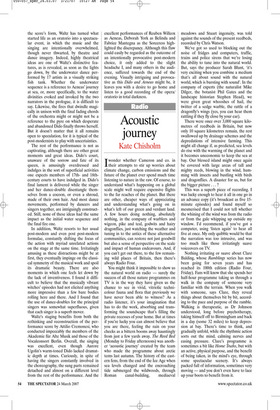Acoustic journey
Kate Chisholm
Iwonder whether Cameron and co. in their attempts to stir up worries about climate change, carbon emissions and the future of the planet ever spend much time listening to nature in the raw. Of course, to understand what’s happening on a global scale might well require expensive flights to the far reaches of the planet. But there are other, cheaper ways of appreciating and understanding what’s going on in what’s left of our green and verdant land. A few hours doing nothing, absolutely nothing, in the company of warblers and wigeon, pike and teal, godwits and hairy dragonflies, just watching the weather and tuning in to the antics of these alternative communities, can restore not just goodwill but also a sense of perspective on the scale and impact of human endeavours. And, if you can’t get out there, to the few remaining wild places of Britain, then there’s always Radio Four.
You might think it impossible to show us the natural world on radio — surely the success of all those nature programmes on TV is in the way they have given us the chance to see in vivid, vitriolic technicolour fauna and flora that previously we have never been able to witness? As a radio listener, it’s your imagination that has to do the work, absorbing and transforming the soundscape that’s filling the private recesses of your home. But at times if you’re lucky you can almost believe that you are there, feeling the rain on your cheeks as a bittern booms away hauntingly from just a few yards away. The Reed Bed (Monday to Friday afternoons) was another ‘acoustic journey’ created by the team who made the programme about arctic terns last autumn. The history of the eastern fens, from the end of the Ice Age when sea levels changed and the encroaching tide submerged the wildwoods, through Roman canal-building, mediaeval meadows and Stuart ingenuity, was told against the sounds of the present reedbeds, recorded by Chris Watson.
We’ve got so used to blocking out the noise of fridges and computers, traffic, trains and police sirens that we’re losing the ability to tune into the natural world. But, says the producer Sarah Blunt, ‘it’s very exciting when you combine a medium that’s all about sound with the natural world, which is bursting with sound’. In the company of experts (the naturalist Mike Dilger, the botanist Phil Gates and the landscape historian Stephen Head), we were given great whooshes of hail, the twitter of a sedge warble, the rattle of a dragonfly’s wings (yes, you can hear them rattling if they fly close by your ear).
There were once over 3,000 square kilometres of reedbeds in Britain, but now only 10 square kilometres remain, the rest swallowed up by drainage schemes and the depredations of intensive farming. This might all change if, as predicted, sea levels do rise with the warming of the planet and it becomes uneconomic to keep the sea at bay. Our blessed island might once again be covered with large areas of tall and mighty reeds, blowing in the wind, humming with insects and bustling with birds and dragonflies. A disaster for us, but for the bigger picture ... ?
This was a superb piece of recording. I was lucky enough to hear it all in one go in an advance copy (it’s broadcast as five 15minute episodes) and found myself so mesmerised that I could not tell whether the whining of the wind was from the radio or from the gale whipping up outside my window. I’d recommend, if you’ve got a computer, using ‘listen again’ to hear all five at once. My only quibble would be that the narration was too intrusive, and was too much like those irritatingly suave voiceovers on TV.
Nothing irritating or suave about Clare Balding, whose Ramblings series has now been going for seven years and has reached its 100th edition (Radio Four, Friday). Fans will know that she spends her half-hour programme taking us through a walk in the company of someone very familiar with the terrain. When you walk with someone, says Clare, they reveal things about themselves bit by bit, according to the pace and purpose of the ramble. Walking is therapeutic, as Dr Johnson understood, long before psychotherapy, taking himself off to Birmingham and back in a day (some 32 miles) to keep depression at bay. There’s time to think, and gradually unfold, while the rhythmic action sorts out the mind, calming nerves and easing pressure. Clare’s programme is sometimes a bit like Home Truths, but with an active, physical purpose, and the benefit of being taken, in the mind’s eye, through some spectacular scenery. It’s always packed full of information, sometimes very moving — and you don’t even have to lace up your boots to benefit from it.


















































































 Previous page
Previous page